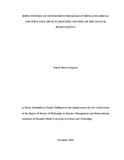EFFECTIVENESS OF GOVERNMENT PROGRAMS IN MITIGATING DRUGS AND SUBSTANCE ABUSE IN SELECTED COUNTIES OF THE COASTAL REGION, KENYA
Abstract
Drug and substance abuse has become one of the looming human-induced disasters globally, making it a profound concern among the comity of nations owing to the significant detrimental effects it has in almost every aspect of life and development. In Kenya, it has become one of the major social catastrophes with the commonest and most easily identifiable manifest in public health. It was, therefore, significant to analyse the effectiveness of various government programs in mitigating drug and substance abuse in the coastal region which continues to witness a steady rise in drugs and substance abuse. Specific objectives of the study were to examine the nature of drug and substance abuse in selected counties in the coastal region, Kenya; evaluate the government programs in mitigating drug and substance abuse in selected counties in the coastal region, Kenya, and; assess the challenges and opportunities facing government programs in managing drug and substance abuse in selected counties in the coastal region, Kenya. The study was underpinned by the interpretivism approach. The study was guided by the social learning theory and functionalism theory. The study used descriptive and evaluative research designs, with data collected through interviews, focus group discussions, observations, and questionnaires. The study was conducted in Kilifi and Mombasa Counties. Data was collected from 552 respondents, who included 384 household heads, 20 victims, 2 county education officers, 2 county commissioners, 2 county health officers, 70 administrative chiefs, 102 village elders, 9 head of NACADA officers, and 8 religious leaders.The study revealed that drug abuse is a significant problem affecting individuals of all ages and socio-economic backgrounds. Commonly abused substances include alcohol 99% (383), khat 98% (378), tobacco 97% (376), cannabis 94% (364), heroin 89% (341), cocaine 88% (337), prescription drugs 85% (326), and methamphetamine 80% (307). Both males 75% (289) and 25% (95) females engage in drugs and substance abuse. The main causes of the menace are unemployment 99% (380), poverty 98% (376), mental illnesses 97% (373) and curiosity 96% (370). Government programs in the study region focused on prevention, treatment, law enforcement, and harm reduction, proving effective to varying extents. Law enforcement and criminal justice programs 363(94%) were found to be most effective, followed by prevention 253 (66%), treatment 146 (38%), and harm reduction programs 153 (40%). Challenges revealed on the government programs included insufficient funding, limited public awareness, Lack of follow-ups and support after leaving treatment centers, and corruption among others. Opportunities identified included government's commitment, community support, and partnerships between government agencies and non-governmental organizations, and reduction of demand and supply of drugs. The study concluded that drugs and substance abuse is a significant problem in the coastal region of Kenya, affecting individuals across all age groups and socio-economic backgrounds, and the government has put in place several programs aimed at mitigating drug abuse, and these programs have been effective to a significant extent. However, there are still several challenges facing the programs, including inadequate funding, inadequate facilities, inadequate staffing in the treatment programs, limited public awareness of the programs, and corruption. The study recommended the re-evaluation of this programs including reinforcing their weaknesses and constant evaluations maximizing on the strengths of the organizations. The study also recommended extensive knowledge and awareness creation on the existence of these programs to aid in the fight against drug abuse in the coastal region.

